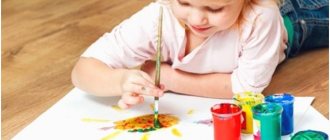How to teach a child to play independently? This question worries many parents. Partly because when the baby is busy with something of his own, mom and dad can devote this time to household chores, do some favorite activity, or just relax. And partly, parents understand that the development of a toddler’s ability to find an interesting activity for himself and the ability to do without adult care for some time is the next stage in the baby’s growing up. Another step towards his development as a person. There is no way to step over it. And how quickly a child learns a new skill directly depends on how much effort his family puts into it.
- 2 Playing space
- 3 What toys are best to offer?
- 4 Child 1-2 years old: where to start?
- 5 Games for children 3-4 years old
- 6 Video “How to get a child to play by himself?”
Why teach your baby to play independently?
Just as a baby cannot eat on his own or, for example, dress himself, he will also not be able to play alone until he is shown how to do it. Moreover, some time must pass for the baby to accumulate certain gaming experience.
A child should be taught to play in the same way as to walk, eat or dress independently.
Playing alone, the baby models life situations, looks for ways out of difficult situations, tries on different images, forms in his mind his own attitude towards good and evil, truth and untruth, etc.
Independent play develops in a child:
- a sense of self-confidence and strength;
- oral language and social skills;
- imagination and imaginative thinking;
- initiative and patience;
- perseverance and ability to overcome difficulties;
- skills in finding alternative solutions.
But all this is possible only on the condition that parents periodically direct the game in the right direction and provide the child with the correct (from the point of view of semantic content) and high-quality gaming equipment.
The toddler must first be taught to play different games, and then expect him to show initiative and some kind of passion for the gameplay.
You need to organize the play space for your baby so that he feels as comfortable as possible while playing.
Source of inspiration
Even the most playful moms need a little extra inspiration sometimes. Some find it in books, some in creativity, some on the Internet. Each method is good in its own way
It is important to find one that will inspire you, awaken your creativity and fuel your desire to play with your child. For example, you can find a couple of interesting sites about playing with children or join a community of mothers who share stories about their activities with babies
The most important thing is not to get stuck at the stage of contemplation, but every day to move on to creative activity, that is, to the practice of playing with your own child.
Play space
To begin with, think about where and what the child will play with, so that you can safely leave him alone for a while. The baby should feel comfortable. And be completely safe at the same time.
Numerous prohibitions will prevent the toddler from being independent and active. Therefore, it is better to foresee all the dangers that may await the baby during play and eliminate them in advance.
Non-slippery floor, light stable chairs, low cabinets with children's things. Anything valuable, breakable and potentially dangerous for the baby should not be within his reach.
Take the issue of storing toys seriously. It should be convenient for the child to take them out and put them back after playing. Arrange the toys so that the baby immediately wants to play with them.
Place a baby doll in a baby stroller, seat guests around a table with toy dishes, build a house from a construction set, and arrange plastic animals according to the plot of some fairy tale familiar to the little one.
Don't limit yourself to buying toys at the store. Household items are also suitable for your child to play independently, as they will allow him to imitate the activities of adults
What else is important to know
If you want to teach your child to play independently, don't forget why you're doing it. Independent games help develop independence and autonomy in a child. He should not feel lonely and rejected.
Don't punish him by spending time alone with yourself. He will hate being alone and will feel unwanted. So don't use it that way.
When your baby insists and asks you to be with him, give him some of your time. But do it well. Put aside all your affairs, gadgets and spend time only with him. Children subtly feel such moments. Therefore, the more persistently you try to leave him alone and do other things, the more he will need you.
What toys are best to offer?
There should be few toys at the toddler’s disposal at any one time. Carry out regular inspections of your baby's household. Hide those in which your child’s interest has faded at the moment, and display those that he has already missed.
Thanks to this trick, you can always captivate your baby by placing a bag of forgotten toys in front of him. In addition, you won’t be able to buy new ones very often.
Toys for independent play
- Toy replicas of household items so that your child can imitate what adults do.
- Anything that will help the baby explore the world, explore the properties of, for example, water, sand, etc.
- Favorite toy friends (teddy bears-hares, dolls) with whom the little one sleeps, eats, and goes for walks. Which are perceived by the child as alive, and with whom he is never sad or bored.
- Secluded shelters (houses, tents, huts). They can be purchased, or you can build them yourself from scrap materials (stools, tables, pillows).
- Strollers, trolleys, radio-controlled or rope-powered cars.
- Sports toys: balls, dumbbells, hoops, jump ropes.
- Games that the baby already knows how to play well, but has not yet lost interest in them.
- A lot of things that are unnecessary, from your point of view (boxes, scraps, bolts, sticks, bags, chestnuts, pebbles, etc.).
Some toys are perceived by the baby as if they were alive; they become his friends, with whom he is not bored or scared. When teaching your little ones to play independently, you can, for starters, play out stories with them
It is better not to purchase interactive toys for independent play. They do not contribute to the development of the child’s imagination; they limit the flight of imagination to the framework of the written program.
And the baby must learn to find a toy in every object in his environment. For kids with good imagination, an empty box turns into a car, a sock into a snake, and daddy’s slipper into a brigantine.
The little one will appreciate bright and expressive toys that can be used for different games, without limiting the methods of use and without being tied to a specific plot.
Early development of children according to Dr. Komarovsky
It is important to remember that the main task of any development is to make the child happy! This primarily includes health, as well as the ability to live in society. An overdeveloped child may have problems communicating, then the acquired knowledge will remain unrealized.
The main principle of any development: using non-violent methods to identify the child’s abilities and without compromising health, and develop the identified abilities.
During the early development of a child, the main points need to be taken into account:
- The child's education should take place in a spacious room or outdoors in a playful way.
- It is best to give a child the knowledge that the child can already use in life. Knowledge is useful when it helps a person live and makes the world around him more understandable.
- The child must understand what is good and what is bad.
- The main thing is that the method of acquiring knowledge does not interfere with the formation of the child’s body. Brain development should not interfere with the full development of everything else. A huge number of health problems in children are due to the fact that they do not move enough.
In the modern world, children quickly learn to distinguish between telephones and car brands, but not the types of trees around them.
However, there are no reliable statistics that a child who has been developed from an early age will be superior to others in the future. Knowledge itself does not make us successful and happy. Knowing more than others does not mean being better than others professionally.
Child 1-2 years old: where to start?
The desire for independence is inherent in a child by nature. You just need to develop it in every possible way. At 1-2 years old, when the baby tries to walk on his own, eat on his own, dress on his own, or help you with the housework, do not interfere with him.
This may not always be convenient for you. Getting dressed for a walk, for example, takes longer, or after eating you have to wash half the kitchen. Be patient just a little.
Skills will come, and with them self-confidence, the desire to cope with assigned tasks, and the ability to cope in some situations (the list of which will expand over time) without the help of adults.
And also, for starters, you should have a few harmless tricks in your arsenal.
Magic bag
Place all sorts of odds and ends in a bright, colorful “bottomless” bag. Of course, when choosing this very thing, do not forget about the safety of the child. These can be small toys, boxes, bottles, beads, shells, etc. Everything that in your baby’s mind is a real treasure. And accidentally leave the little one alone with the magic bag. Mandatory conditions: do not forget to update the contents of the bag from time to time and do not give it to your child too often.
I wonder how long the contents of the closet will captivate the little one?
Treasured wardrobe
Within the reach of the baby, “accidentally” forget to close the closet door, which he recently so persistently tried to look behind. First, again, check that there is nothing valuable or dangerous lying there. And leave the room. I wonder, busy with research, how long the baby will not notice that you are not next to him.
Mom's bag
What toddler doesn’t dream of tidying up his mother’s bag? So give your little one this opportunity. True, first carry out an audit of it yourself and leave only what you don’t mind and what is completely safe for the little naturalist. The bag is unlikely to replace you completely, but for a while the baby will definitely be satisfied with it.
Don't expect instant results. The child will undoubtedly learn to play independently. But this will take some time. Some have more, some have less. It depends on the baby's temperament. And also on your competence in this matter and on your patience.
You must comply with some mandatory conditions when teaching your baby to spend time without you.
Firstly , the little one must feel good and be in a good mood during any learning process.
And, secondly , playing alone should not be a test for the baby - follow moderation, there is no need to insist if the baby does not like this course of events.
At 3-4 years old, the child begins to play role-playing games and build more complex storylines
Developing imagination
Show your imagination in your games, and your baby will learn to fantasize with you. From the age of one, a child can understand many images. For example, a cube in your game can be soap for a doll, a stick can be a spoon or a thermometer. You can imagine that the grass is pasta, and the pebbles are potatoes and cook soup from them. Such images greatly develop a child’s imagination.
From time to time, in games with my daughter, I used similar images and by the age of 2 I noticed that she began to fantasize on her own, to come up with completely new associations that I had not taught her. So, for example, Tasya took a stick in each hand and, crossing them, moved one stick over the other, and told us that she was playing the violin. Or she would put the box open on one side on its side, sit in front of it and say that she was watching TV.
Games for children 3-4 years old
With the accumulation of gaming experience (and this is approximately by the age of three or four), the child is ready to move on to a new form of independent play - role-playing. At the same time, mom and dad can offer new stories and help the baby build more complex combinations.
What do preschoolers play?
- With dolls (to daughters and mothers, to family, to hospital, to store, to different professions).
- With cars (for cargo transportation, taxis, car dealerships, parking).
- With animals (to the farm, to the circus, to the zoo).
- With sports toys (relay races, tournaments, training).
- They play out the plots of their favorite fairy tales and cartoons.
- They love to play dress-up games.
Parents can be partners, advisers or outside observers, but the rules of the game should always be set by the child himself. There will be a time for playing by the rules
At this age, the main condition for relatives is not to impose their vision. At 3-4 years old there is no need to limit your child’s imagination. You can be a partner or an outside observer, an adviser. But the rules must be set by the child.
And remember, the more they play with the baby, the brighter his interest in games becomes, and the faster he begins to play on his own.
Conditions and techniques for teaching a child to play independently
Correct selection of toys
The main condition on which the development of a child’s independent play activity depends is the correct selection of toys. What toys are suitable for a young child? Of course, these will be cubes, balls, swings, spinning tops, pyramids, tumblers, nesting dolls, cars, hoops, strollers, children's dishes and furniture, dolls, etc. The main thing is that all toys are made of high-quality material, are easy to wash, are bright and aesthetically attractive.
Adult example and imitation
Another condition for success in the development of independent play activity is showing adults how to use toys. Despite the fact that we are talking about independent activity, a child at this age is still very dependent on help from an adult: he needs to give something, open something, draw something for him. But gradually the baby, seeing the actions of an adult, copies them and transfers them into his own activities.
Help around the house
For the development of independent play activity of a child, the enrichment of his impressions is also of great importance. For this purpose, the child should be involved in any feasible work, for example, watering flowers, wiping dust, arranging cups, etc. The result of such involvement in work will be the use of the experience gained in the game.
Creating game situations
In the process of organizing and directing a child’s play activity, one should consider making the conditions in which it is carried out more complex. To do this, a special combination of methodological teaching techniques should be used: first, all actions with toys are performed on the basis of joint actions (hand in hand), then conjugate ones (step-by-step repetition), and then only a reminder of some actions. An excellent methodological technique that stimulates a child’s play activity is the creation of problematic situations.
For example, you can draw the baby’s attention to the fact that his doll is dirty. This can be accompanied by the following words: “Mashenka, your doll Katya is dirty
Where do we have soap and a towel?” Thus, you do not tell the baby that the doll needs to be washed, but encourage him to perform imaginary actions with the toy.
Rules of the game
In the process of guiding the independent play activities of a young child, one should pay close attention to the formation of volitional qualities of the individual. So, you always need to teach your child to finish what he has started, act according to the rules, handle toys with care, put them in their place, etc.
The child grows, new games and toys appear, play activities become more complex, and independence increases. But you must remember that this does not arise spontaneously, but only with proper guidance on your part.
If adults correctly organize the independent play of a young child, the result will be an excellent mood, positive emotions, adequate use of toys, and a friendly attitude towards adults and peers.









